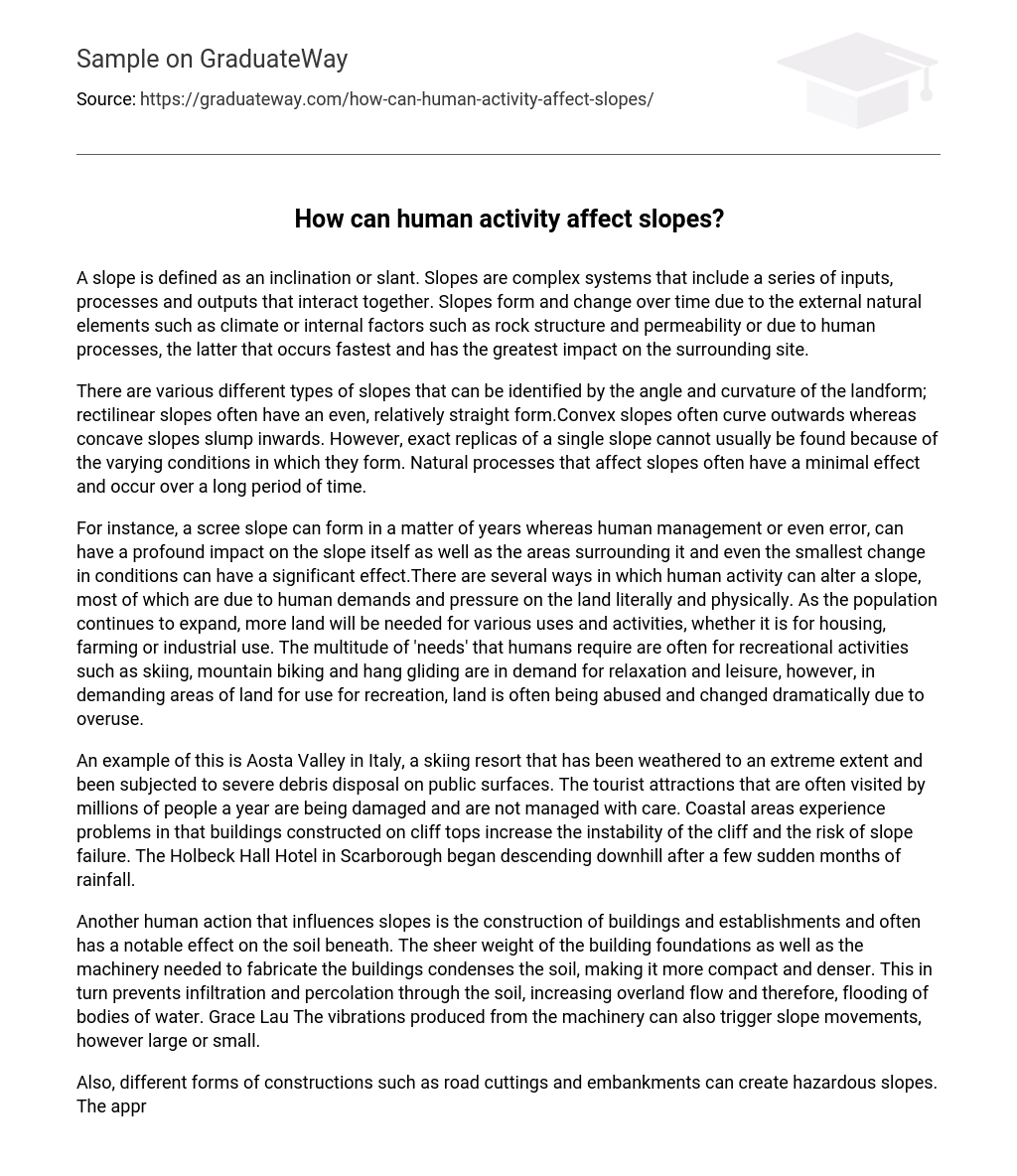A slope is a slant or inclination, which involves multiple inputs, processes, and outputs that interact. The formation and alteration of slopes are affected by external natural elements like climate and internal factors such as rock structure and permeability. Human activities can also have a faster impact on the slope and its surroundings compared to natural processes.
Different types of slopes can be recognized based on the angle and curvature of the landform. Rectilinear slopes have a generally even and straight form, while convex slopes curve outward and concave slopes slump inward. However, it is unlikely to find identical replicas of a single slope due to the different conditions under which they are formed. Slopes are influenced by natural processes that typically have a gradual impact over an extended period.
Human activity can rapidly and significantly impact natural slopes and their surroundings. Even small changes in conditions can have noticeable effects. The need for land, driven by population growth, is the main driver behind the alteration of slopes due to human activity. More land is needed for housing, agriculture, industry, as well as recreational activities like skiing, mountain biking, and hang gliding. However, this demand often results in excessive use and abuse of the land, causing drastic alterations.
Italy’s Aosta Valley is an extreme example of a skiing resort that has faced extensive weathering and severe debris disposal on public surfaces. The lack of careful management has led to damage to the tourist attractions frequently visited by millions of people each year. Similarly, coastal areas face issues when buildings are constructed on cliff tops, as this can enhance cliff instability and the risk of slope failure. The Holbeck Hall Hotel in Scarborough, for instance, started to descend downhill after a few months of sudden rainfall.
The construction of buildings and establishments is another human action that impacts slopes. It has a significant impact on the soil beneath due to the weight of the building foundations and the machinery used in constructing the buildings. This causes the soil to become compact and dense, limiting infiltration and percolation. Consequently, overland flow increases, leading to flooding of bodies of water. Additionally, the vibrations generated by the machinery can trigger slope movements, regardless of their size.
Different forms of constructions, such as road cuttings and embankments, can create hazardous slopes that require appropriate precautions for safe maintenance. Even seemingly gentle slopes can become unstable due to the action of gravity, precipitation, and climate, resulting in soil creep. In the Isle of Wight, there is an occurrence of rotational slip, specifically in retirement bungalows, which is believed to eventually cause a landslide.
Land in certain areas is typically only appropriate for particular purposes. In agriculture, the slopes’ angles and other factors are crucial in deciding if land is suitable. Steep slopes at lower elevations have great potential, but there are limitations like operating heavy machinery. The Champagne region in France illustrates effective slope management by evaluating slopes for their ability to support vine growth. This approach successfully combines utilizing slopes for human needs without causing natural disasters.
Despite ongoing efforts, soil erosion remains a persistent issue, especially on poorly managed agricultural land. The problem continues and can only be stopped through human intervention. A similar case of insufficient slope management is observed in Hong Kong, where the majority of the terrain consists of hills and mountains, emphasizing the importance of slope safety. Sadly, in the last 50 years, landslides on man-made slopes have caused over 470 tragic fatalities.
The inadequate maintenance of slopes is a major factor behind many landslides in Hong Kong. As a result, there is an ongoing endeavor to establish preventive measures. Furthermore, the elimination of indigenous plants and trees from an area also contributes to the hazards and calamities. The roots of these vegetation species serve as crucial stabilizers for the soil and soft sedimentary rocks through their binding capabilities. They effectively hinder materials from becoming easily detached from the soil, which on occasion can trigger landslides.
Trees typically have a positive impact on slopes by enhancing soil cohesion and friction. Human intervention, through surface paving, water channelling, and other activities, can unintentionally or deliberately alter the balance of water infiltration and runoff. Though certain human actions may contribute to slope-related disasters, it is usually the combined effect of multiple activities that leads to such catastrophes. Urban areas are often more susceptible to mass movement disasters, and the subsequent repair costs for various items can be significant.
The management of slopes, whether natural or artificial, is important for preventing potential hazards. Industries that produce large amounts of waste heaps must carefully stabilize them to ensure safety. An example of the consequences of unstable slopes is the Aberfan disaster in Wales, which resulted in the death of 147 people, mostly children, due to the instability of a coal mine spoil heap. As a result of this tragedy, measures have been taken to reduce the gradient of Grace Lau spoil heaps and prevent similar events from occurring.
The frequency of human-caused disasters exceeds that of natural ones. It is crucial to recognize the significance and consequences of slopes in order to avert such incidents. Nonetheless, present slope management methods must be reassessed for better success rates. These perils lead to loss of life, property destruction, and diverse complications. The most effective approach to prevention entails understanding and awareness regarding the dangers posed by both natural and human-induced disasters. Hill slopes and vegetation play a pivotal role in determining slope stability, hence the removal of vegetation should be carefully deliberated.
The significance of planning should be emphasized in order to reduce risks in human activities.





